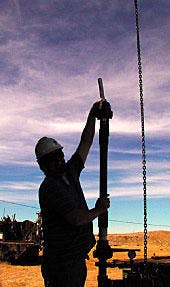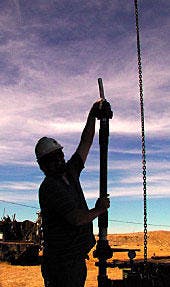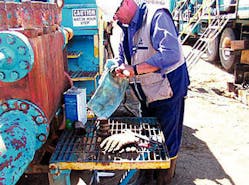A field demonstration at the Rocky Mountain Oilfield Testing Center (RMOTC), near Casper Wyo. showed that a thermochemical capsule dropped down tubulars effectively removed paraffin blockage.
The KKG Group, a Russian-American partnership based in Vancouver, Wash., and Krasnoyarsk, Russia developed the capsules.
The technology is for wells in which the capsule's fall is not obstructed. The technology could replace such paraffin removal techniques as mechanical cutters, injection of microbes or chemicals, and hot-oiling of wells.
In wells with sucker rods, the rods would have to be removed prior to dropping the capsule.
Device description
KKG describes its capsule as a long, cylindrical metal tube with a 150-mm length and a diameter of 28-36 mm that contains different metals in powdered form. The tube's length and diameter may be adjusted depending upon well conditions.
In the first step of the process, one must first remove a circular foil covering one end of the capsule before dropping the capsule into a lubricator. Sodium is the active agent in all formulations placed in the capsule. When the sodium comes into contact with water, the thermochemical reaction generates enough heat to melt paraffin and release hydrogen gas, according to KKG.
In a situation where no water is present in a well, KKG says water may be added through the lubricator.
The capsule will completely consume itself, leaving no residue in the tubing, and KKG says there are no environmentally harmful byproducts. It indicates the small amount of sodium left on surface when the end of the capsule is removed, prior to dropping it in the well, can be disposed of by placing the sodium in a small container of oily water and allowing it to consume itself with no residue.
KKG says some formulations placed in the capsules also contain a gel in the middle that deposits on the inside of the tubing and prevents new paraffin or asphaltene to accumulate. Its analysis shows that the gel deposition prevents buildup of new paraffin or asphaltene to the extent that time between cleaning can be increased by anywhere from three to eight times. That is, if the normal cleaning period is 1 month, it can be extended to anywhere from 3 to 8 months, depending upon the chemical composition of the oil being produced.
To insert the capsule, two men typically are needed to install a lubricator but other specialized equipment and workover units are not required. The wells do not have to be shut in before dropping the capsules. KKG does indicate that some operator training is necessary, primarily for determining the correct formation for different oils.
It says, a well may be scrubbed clean in anywhere from 1 to 3 hr, using one or two capsules, depending on the amount of paraffin or asphaltene present. In practice, KKG says the capsules can break through paraffin plugs that have completely choked off oil flow, although it will almost always take more than one capsule to clean a well.
Testing
KKG says the experience in Russian with similar technology in several hundred wells has shown the effectiveness of this technique at removing paraffin and ashphaltene buildup. These applications did show that sodium in its pure form can be dangerous if not handled properly. KKG indicated that some early capsule formulations damaged wells, but it has not noted any incidents of damage in the past 2 years, if trained technicians supervise the process.
At RMOTC, KKG ran two separate tests on 2 days. In both cases, KKG says the tests were run under conditions that simulated an actual producing oil well.
It says the tests were conducted in an empty casing string with a plug at about 350 ft and ten 30-ft joints of 23/8-in. tubing. A mixture of oil and water was pumped down the annulus between the casing and pipe to simulate oil production.
The first test included seven clean pipe joints and three joints with varying degrees of paraffin blockage. One joint was completely blocked and the other two had significant paraffin deposits.
In the second test only two joints were run with significant paraffin deposition.
KKG says the results in the first test after inserting four capsules and removing the pipe for inspection showed that the capsules had cleaned completely the blocked joint and one other joint with paraffin deposition. The remaining joint was substantially cleaner, although not completely clean.
It says the second test generated similar results, and it attributed the remaining paraffin to insufficient testing time.
Currently, KKG is searching for other locations to test its technology.




